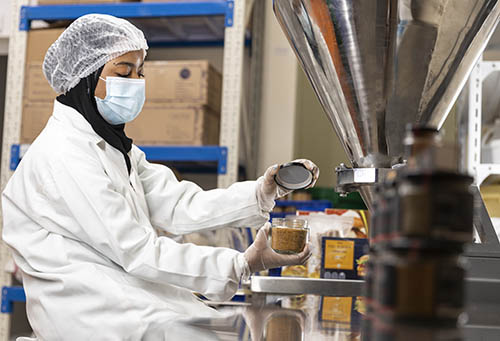



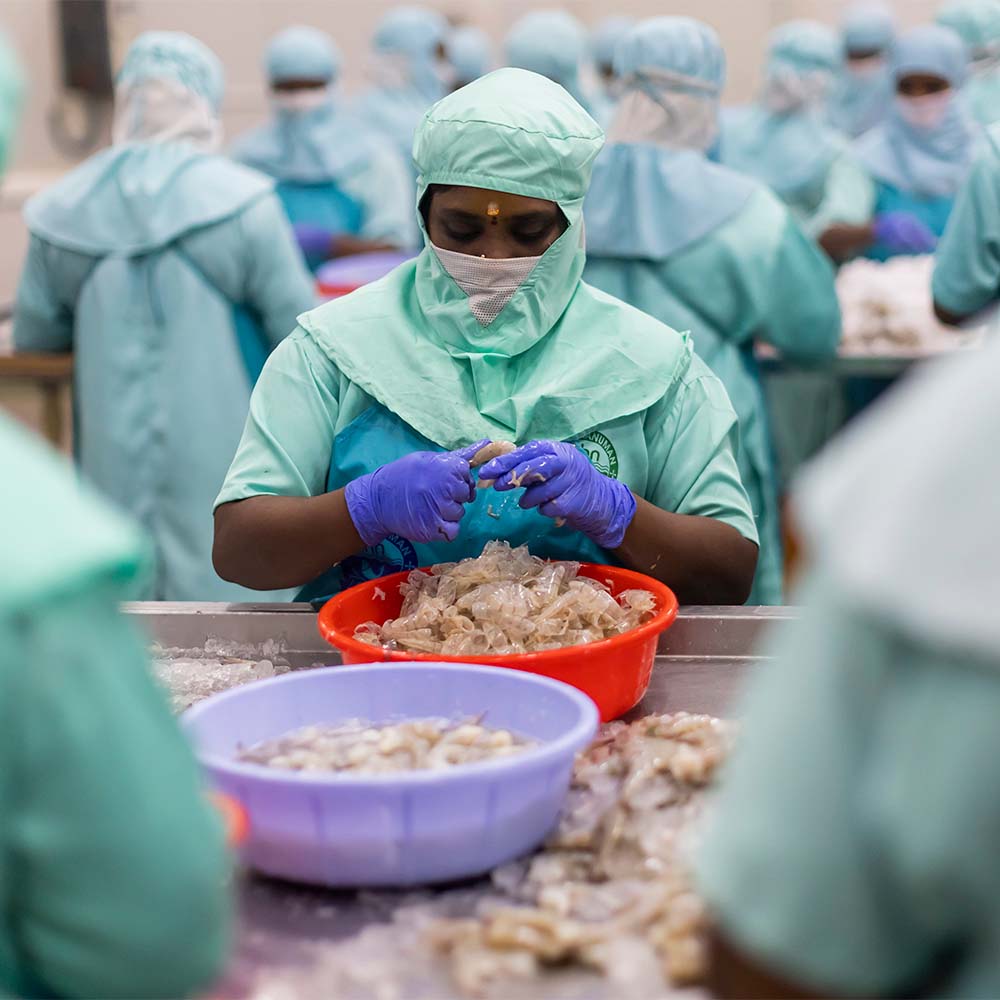


The State of Food and Agriculture (SOFA) 2010–11: Women in Agriculture – Closing the gender gap for development1 made the business case for closing existing gender gaps in accessing agricultural assets, inputs and services. It documented the tremendous costs of gender inequality not only for women but also for agriculture and, through agriculture, for the broader economy and society as a whole.
Much has happened since 2011. The critical importance of achieving gender equality and empowering women as a goal of the 2030 Agenda for Sustainable Development is increasingly recognized and accepted at all levels of governance. Increased attention has been given to gender equality in agricultural policymaking, development and humanitarian interventions, and institutional strengthening and to enhancing women’s participation in positions of leadership. Significant improvements have been made in the availability of sex-disaggregated data and gender statistics. An increasing amount of research has explored the nature and drivers of women’s empowerment and gender equality.
However, while some gender gaps have been reduced, little or no progress has been achieved in others. Women represent half of the global population but continue to be systematically disadvantaged across different dimensions of welfare and economic livelihoods. In 2021, for example, globally 31.9 percent of women were moderately or severely food insecure compared with 27.6 percent of men, a gap of 4.3 percentage points (see Box 1.1).2 Women and girls face barriers and constraints that men and boys do not as a consequence of rigid gender norms and roles, unequal power dynamics and discriminatory social structures. The dramatic impact of the COVID-19 pandemic exposed the fragility of earlier gains in women’s empowerment and highlighted the implications of the persistence of structural inequalities and multiple and intersecting forms of discrimination affecting women and girls. These impediments to women’s progress are compounded by the additional challenges posed by climate, economic and price shocks, conflicts and the increasing risks of gender-based violence.
Women are more food insecure than men in every region and the gap has widened since the outbreak of the COVID-19 pandemic.i Globally, the gap between men and women in the prevalence of moderate or severe food insecurity (Sustainable Development Goal Indicator 2.1.2) increased from 1.7 percentage points in 2019 to 4.3 percentage points in 2021, driven largely by the widening differences in Latin America and the Caribbean and Asia. More than 939 million women aged 15 or older experienced moderate to severe food insecurity in 2021, compared with 813 million men in the same age class (Figure A).
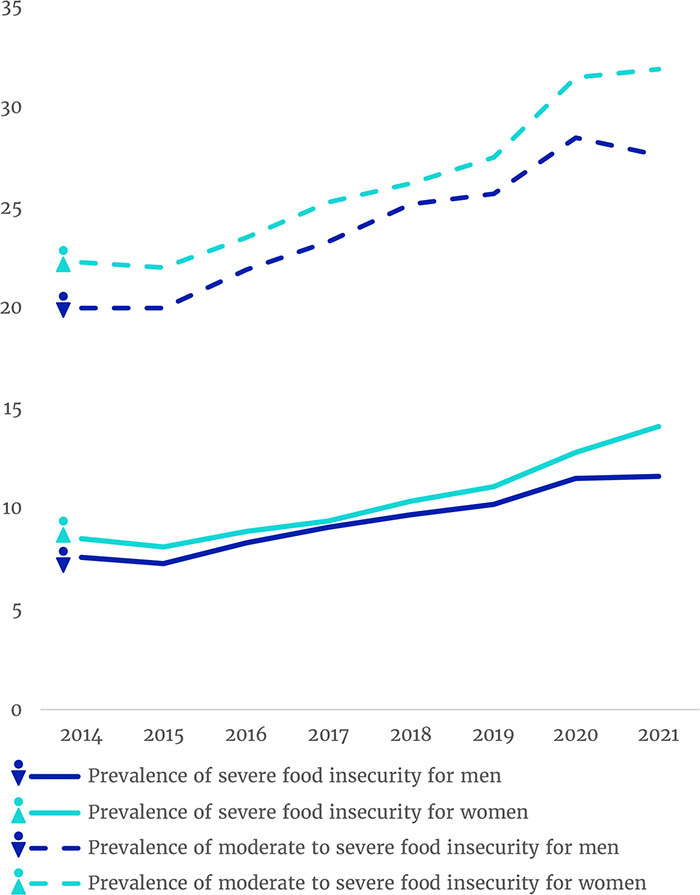
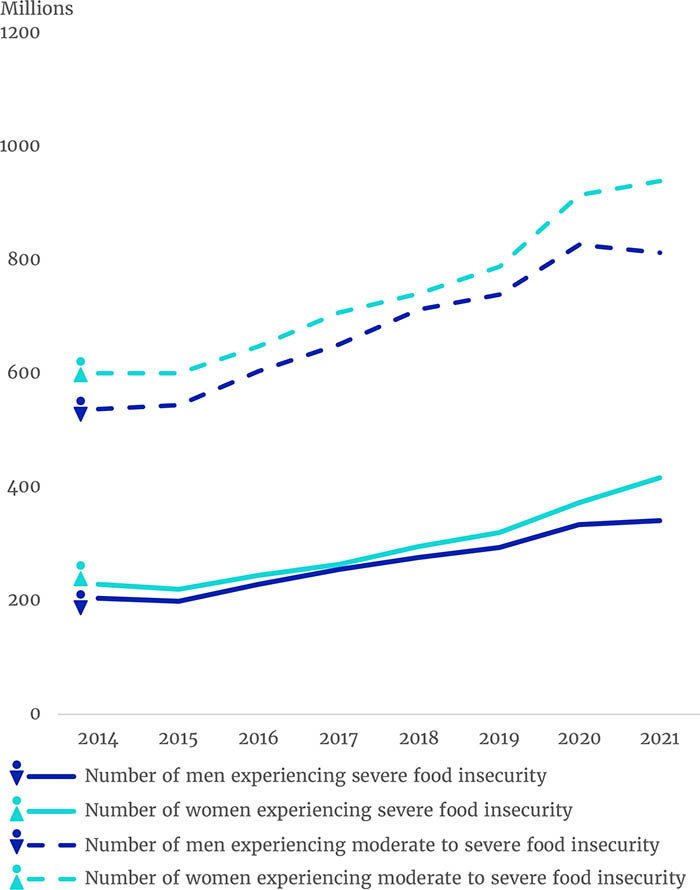
The gender gap varies considerably across countries. Most of the 24 countries where food insecurity is significantly higher among women than among men are concentrated in Africa, Asia and Latin America and the Caribbean (Figure B). Food insecurity is significantly higher among men in only four countries.

An econometric analysis of Food Insecurity Experience Scale (FIES)ii data collected through the Gallup© World Poll (GWP)iii from more than 700 000 individuals in 121 countries before and after the outbreak of the COVID-19 pandemic shows that women in rural areas and men and women in the 25-34 age group have been disproportionally affected since the outbreak of the COVID-19 pandemic (Figure C).iv At the global level, people between the age of 15 and 24 and those over 65 are generally more food secure, and females in the age group 25–34 are more food secure than those aged 35–64. The differences by sex, residence and age are significant even after controlling for income, education, employment, marital status and household composition, indicating that other unobserved factors, including gender norms and discrimination, continue to hinder women’s food security in rural areas.

Women often have lower levels of education and less full-time employment and participation in the labour force than do men and come from households with less income. At least 57 percent of the current gap in food insecurity between women and men would disappear if these three gender gaps were eliminated.iv
NOTE: Mane et al. (forthcoming)iv use a Tobit model to analyse the socioeconomic determinants of food insecurity (Figure C), defined as the probability of moderate or severe food insecurity, by regressing it on the following variables: Female = 1 if sex is female; Rural = 1 if individual lives in a rural area; four age groups (15-24, 25-34, 35-64 and 65 plus); and other control variables (marital status, employment status; education level, number of household members aged 15 or more, the number of household member younger than 15 and income per capita in international USD purchasing power parity).
A global consensus on the interdependence of development objectives emerged in the 2000 Millennium Development Goals and the 2015 Sustainable Development Goals. This underlined the centrality of addressing gender equality within a broader approach to sustainable economic and social development. In this report we thus move beyond the focus of SOFA 2011 – women in agriculture – towards one on broader gendered agrifood systems within dynamic processes of agricultural, rural and structural transformation. Moreover, since 2011 the societal objective has moved beyond reaching equality in economic activities to gender equality and women’s empowerment, both as goals in and of themselves and as means to improve an array of welfare outcomes. As a consequence, the policy space has moved from closing gender gaps towards the adoption of gender-transformative approaches, which explicitly address both the formal and informal structural constraints to equality and more balanced power relations.
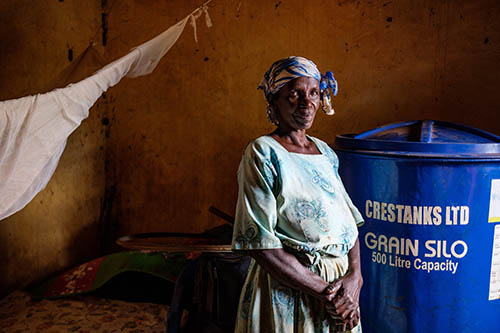


The status of women in agrifood systems goes far beyond an update to the SOFA 2011 report on women in agriculture, in that it provides a comprehensive view of the status of women in agrifood systems globally. It presents new data and findings about how women participate in, and benefit from, agrifood systems and investigates how shocks in agrifood systems have a differential impact on men, boys, women and girls and the coping strategies with which they have responded. The report reflects not only on how gender equality and women’s empowerment are central to the transition towards sustainable and resilient agrifood systems but also on how the transformation of agrifood systems can contribute to gender equality and women’s empowerment. It provides a comprehensive analysis of the available evidence on gender equality and women’s empowerment in agrifood systems that has been produced over the last decade. The report also provides policymakers and development actors with an extensive review of what has worked and makes specific recommendations on the way forward.
The report highlights the centrality of intersectionality – how multiple and often overlapping and intersecting factors such as age, gender, ethnicity, health, disability and socioeconomic, marital and migration status combine to create different modes of discrimination, social exclusion, and privilege – in addressing gender equality and women’s empowerment (see Box 1.2). It also places greater emphasis on the intertwined nature of the social and economic dimensions of women’s and men’s lives. The phenomenon of gender-based violence is included where relevant throughout the report (see Spotlight 1.3).
The behaviour, choices and opportunities of women and men are shaped by multiple overlapping and compounding factors that lead to social and economic differentiation (Figure A). At the individual (or intrapersonal) level, these factors include gender, age, ethnicity, religion, disability and marital, economic, migration and health status. Social and economic differentiation are also influenced by context-specific social norms, roles and traditions (interpersonal); public and private institutions, policies and governance (structural); and the broader climate and environment (ecological). Adopting an intersectional perspective to gender equality and women’s empowerment involves explicit recognition of all these factors in problem analysis and the design of programmes and policies.i
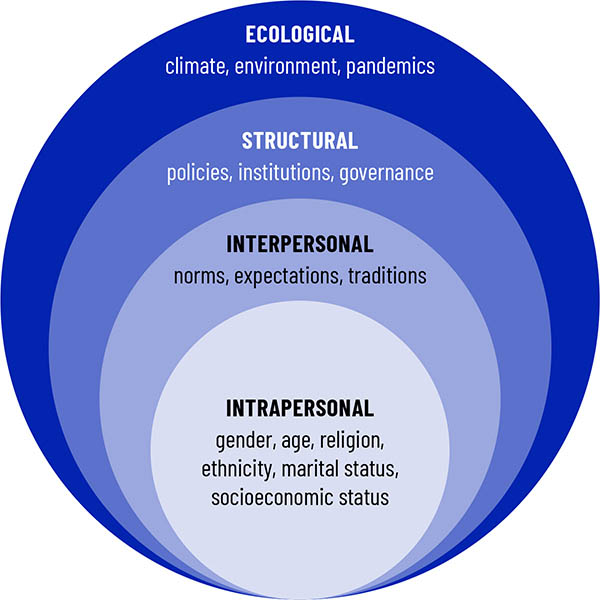
This report stresses the importance of an intersectional perspective in research, policies and programmes to support development of inclusive agrifood systems. Examples in this report include migrant women wage workers in global commodity chains (Chapter 2); time use agency and household structure in Nepal (Chapter 2); mobile internet use along the rural-urban divide (Chapter 3); women’s monogamy/polygamy marital status and experience of intimate-partner violence in cash-transfer programmes in Ghana and Mali (Chapter 3); and the gender specificities of child labour and climate change in Côte d’Ivoire, Ethiopia, Nepal and Peru (Chapter 5).
Gender-based violence (GBV) refers to harmful acts targeted towards men and women or groups of individuals based on gender.i Such acts cause economic, psychological, physical and/or sexual harm and are deeply entrenched in gender inequality, power imbalances and harmful social norms. GBV transcends economic, geographic and social boundaries and has long-lasting consequences for the individuals directly affected and for their families and communities. It may be perpetrated by intimate partners, relatives, friends, acquaintances or strangers; online or offline; and in private or public spaces.
GBV highlights the increased vulnerability of women and girls to violence as a result of their subordinate status in society, unequal power relations and gender roles.ii GBV is also increasingly being used to refer to men and boys and to people who do not follow traditional gender roles including LGBTIQ+ – an inclusive term representing individuals who identify as lesbian, gay, bisexual, trans and gender diverse, intersex, queer and questioning.ii
Globally, one-third of women have been subjected to physical and/or sexual violence in their lifetime.iii Most of this is intimate-partner violence (IPV) perpetrated by men against women: 27 percent of women between the ages of 15-49 who have been in a relationship have suffered some form of IPV. Thirty-eight percent of all murders of women are committed by intimate partners.iv Such numbers are considered underestimations given that GBV, including IPV, is typically underreported.v Violence against men, boys and LGBTIQ+ people is often overlooked and severely underreported because of the stigma attached to such violence and because the victims lack resources and support.vi
Reported levels of physical and sexual violence vary widely by context, but such violence occurs in every setting. Figure A shows the percentage of rural women reporting physical and sexual violence in selected countries around the world since 2015. Women reporting any physical violence ranges from 7 percent in Armenia to 64 percent in Sierra Leone, while any sexual violence ranges from 1 percent in Armenia to 28 percent in Papua New Guinea.
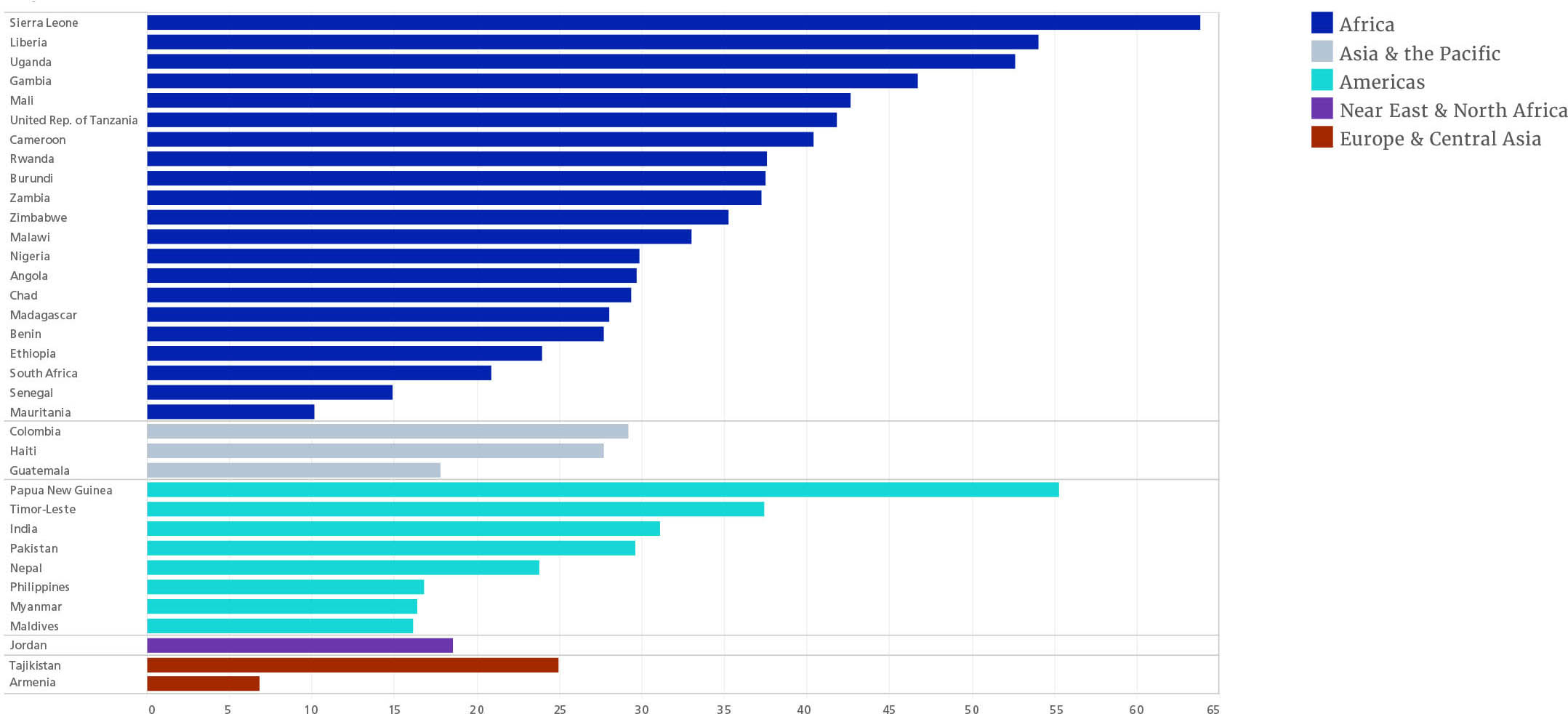
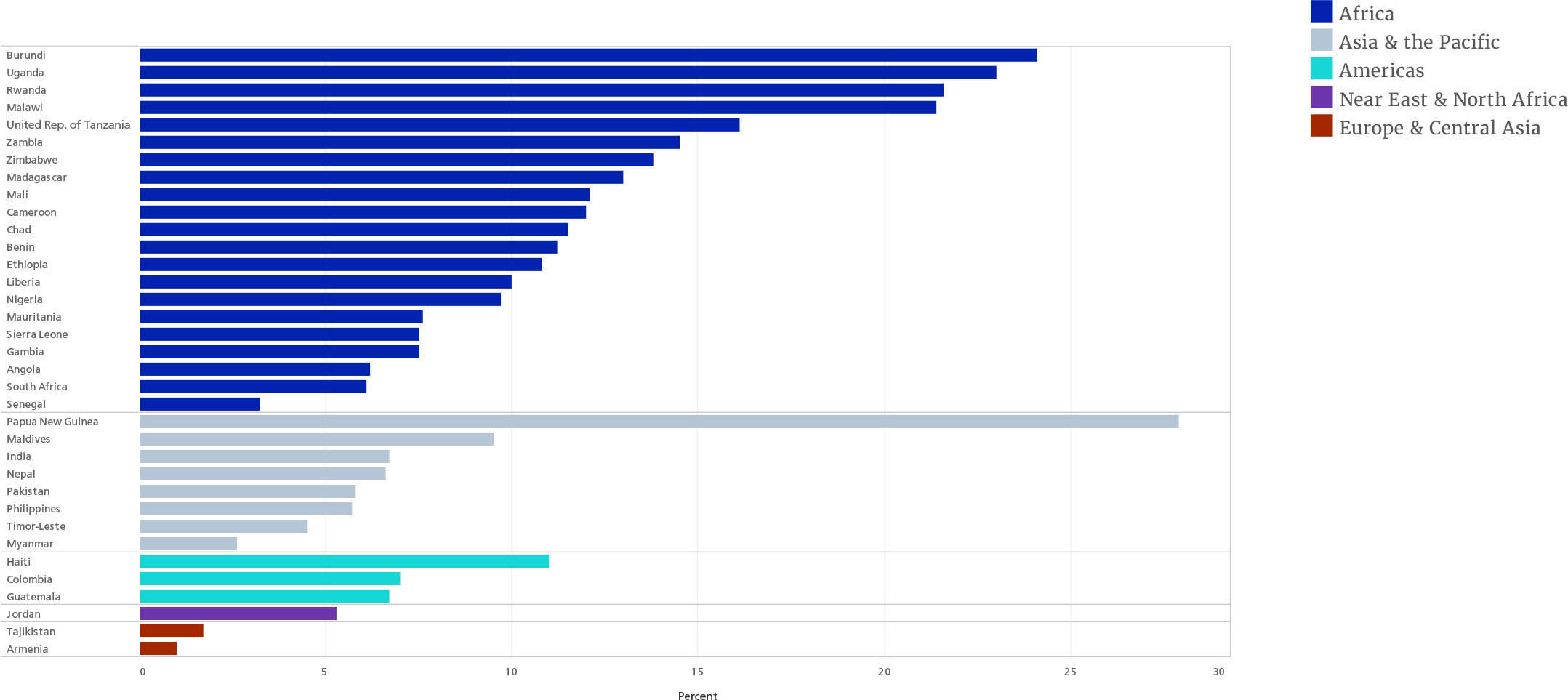
Globally, violence against women is estimated to cost USD 1.5 trillion annually, equivalent to 2 percent of global GDP.vii, viii Global crises and the recent COVID-19 pandemic have further increased violence against women and girls, with significant implications on their livelihoods and food security.
GBV inhibits rural development and the achievement of food security and nutrition through several channels. It leads to large costs at individual, family, community and societal levels and to governments and the private sector. While GBV is historically rooted in unequal power relationships between men and women, it is both a cause and consequence of poverty and food insecurity.ix As a result, it may lead to increased household tensions and reinforce inequality and discrimination, driving further GBV. Loss of income, productivity and resilience and increased medical costs from GBV may exacerbate poverty.x For rural women and girls, increased poverty-related stress and food scarcity and restricted freedom of movement may lead to increased dependence on male partners and negative coping mechanisms such as transactional sex and other forms of sexual exploitation.xi
To combat GBV in agrifood systems and beyond, governments and humanitarian and development actors have explicitly focused on increasing gender equality and freedom. For example, the United States Agency for International Development (USAID), the African Union and UNICEF have incorporated the objective of ending violence against women and girls in their gender equality and women’s empowerment strategies. They also emphasize the need to do no harm, adopt multisectoral strategies and engage men and boys as allies for transformational change.
Effective laws, policies and institutions, and women’s representation in leadership and decision-making are also crucial in the fight against GBV.xii, xiii Because men and boys serve as gatekeepers in roles of household and community leadership and may perpetuate GBV and unequal gender norms, engaging them as allies in addressing GBV is integral to the process towards the elimination of violence against women and girls.
Throughout this report, we highlight how GBV manifests within agrifood systems; take stock of the limited evidence on GBV across value chains, food environments and consumer behaviour; provide examples of what works to address and prevent GBV; and identify gaps in existing knowledge to orient future research. The report highlights how recent events such as the COVID-19 pandemic, conflict and recurring extreme weather and climate events have the potential to trigger and exacerbate GBV among already vulnerable populations.
Moving from a focus on the status of women in agriculture to women in agrifood systems broadens substantially the coverage and the findings of this report. Agrifood systems comprise the entire range of actors and their interlinked activities that add value in food and non-food agricultural production and related off-farm activities such as food storage, aggregation, post-harvest handling, transportation, processing, distribution, marketing, disposal and consumption (Figure 1.1). Food systems – a subset of agrifood systems – comprise all food products derived from crop and livestock production, forestry, fisheries and aquaculture and from other sources such as synthetic biology. Globally, these food systems produce some 11 billion tonnes of food each year and almost four billion people worldwide live in households linked to food systems livelihoods.3
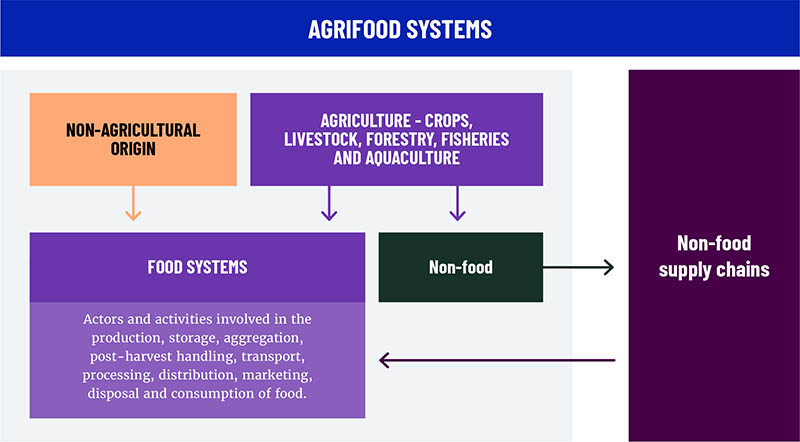
Agrifood systems also interact with non-food supply chains. This includes purchase of inputs such as fertilizer, pesticides and farm and fishing equipment and provision of inputs for the production of non-food commodities (e.g. cotton for textiles). Agrifood systems and their diverse production systems are in turn shaped and influenced by broader economic, social and natural environments.
The key actors in agrifood systems include primary producers; service providers such as those supplying inputs and post-harvest, storage, transport and food processing services; and food distributors, wholesalers and retailers. Households and men and women within households participate as self-employed production units and small businesses, wage workers and as final consumers.
Agrifood systems are dynamic and continually changing, both driving and being influenced by processes of agricultural, rural and structural transformation.4 Agrifood systems historically have been successful in providing enough food for a growing world population and have contributed to poverty reduction and increased welfare, but this has been at the cost of increasingly negative nutritional and health outcomes, environmental unsustainability and inequality. A concerted and directed effort is required to move agrifood systems towards nutritional, environmental and equality objectives.5
Most employment for both women and men is found in agrifood systems in low- and middle-income countries and specifically in agricultural (including crop, livestock, fisheries and forestry) production, which continues to be the main motor of economic development and poverty reduction. But as economies develop, the proportion of men and women working in agrifood systems falls (Figure 1.2, Panel A). This trend is driven primarily by a reduction of employment in agricultural production. Within agrifood-systems employment, the composition shifts from agricultural production (Figure 1.2, Panel B) to off-farm activities, including transport, processing, distribution, storage and marketing (Figure 1.2, Panel C). The gender differences in these patterns are described in detail in Chapter 2.

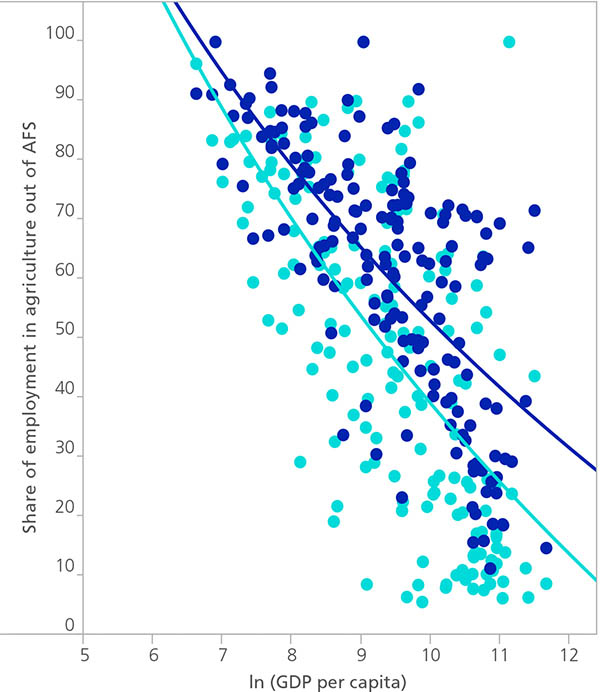

Agricultural, rural and structural transformation, and the shift of employment out of agriculture and agrifood systems they imply, are accompanied by increases in labour productivity and an improving average standard of living. The shift of employment in agrifood systems from agriculture to non-agricultural, off-farm activities is part of this process. As this occurs, better-paid jobs for both men and women are increasingly found in off-farm activities in agrifood systems and outside agrifood systems. However, as is described in Chapter 2 of this report, women do not benefit as much as men from the opportunities provided by this process. This is true in agricultural production, the off-farm segment of agrifood systems and outside agrifood systems.
Women do not benefit as much as men from the opportunities provided by agricultural and rural transformation.
Taking the framework for gendered agrifood systems from Njuki et al. (2022)6 as a starting point (Figure 1.3), we look at women’s participation in all parts of agrifood systems, on and off farm (production, processing, distribution, marketing, entrepreneurship and consumption). This framework facilitates a focus on specific outcomes generated by agrifood systems such as nutrition, empowerment, sustainability and a wider range of livelihoods; considers a broad set of resources, policies and norms; and addresses new challenges and shocks such as climate change and COVID-19, and the growing overlap of these challenges with conflict. Value chains within agrifood systems (including agricultural production, processing, distribution and storage, and marketing), the food environment and consumer behaviour are all subject to biophysical, environmental, technological, infrastructural, political, economic, sociocultural and demographic drivers (blue boxes in Figure 1.3). Each of these drivers is conditioned by structural inequalities linked to gender and/or intersecting social and economic differentiation, which are referred to throughout this report.
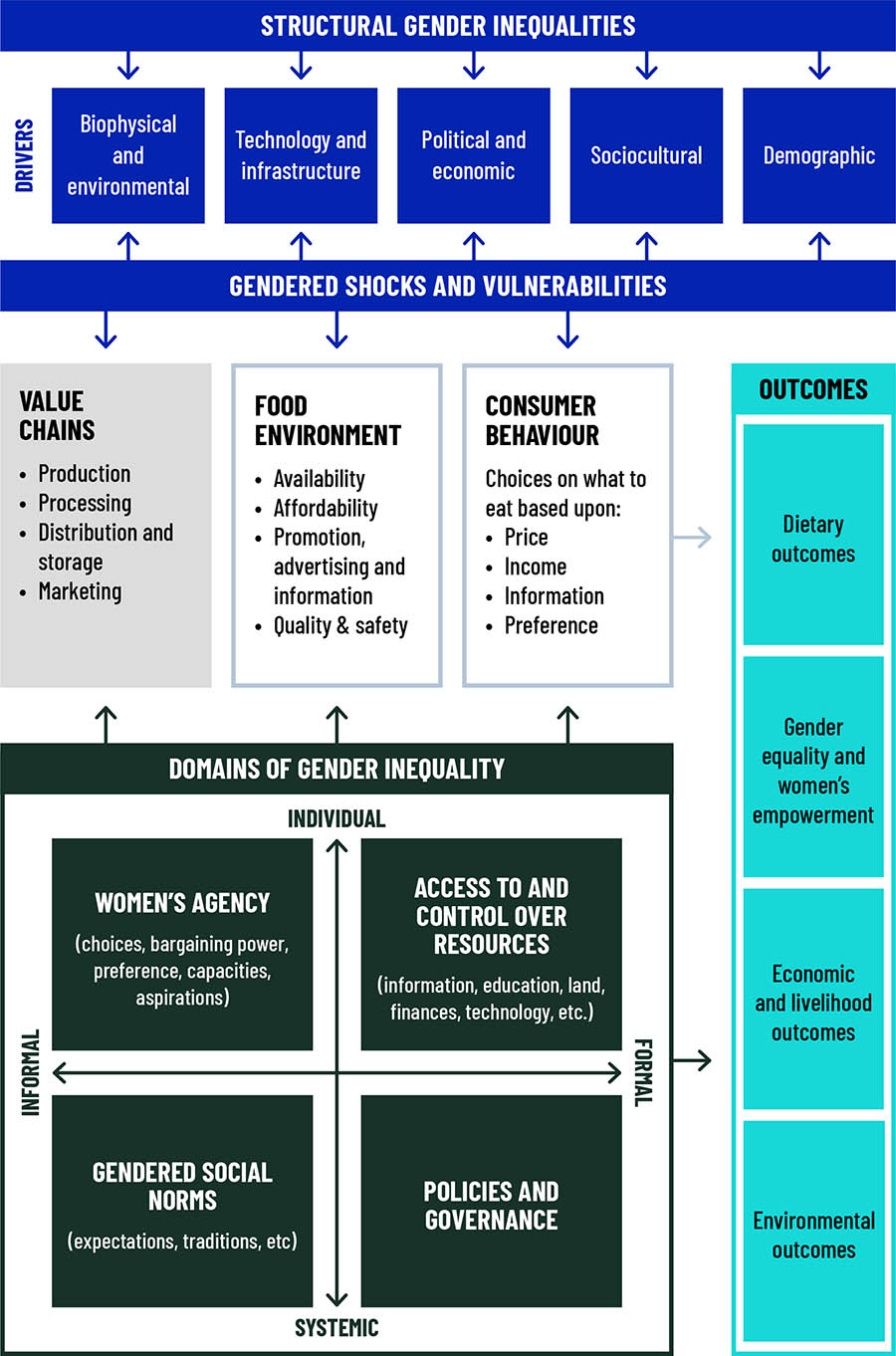
The drivers are also influenced by shocks and vulnerabilities (as described in Chapter 5) that often have different impacts on women and men, girls and boys, in part due to gendered and social group–specific differences in access to resources, services and local institutions that can mitigate the negative impacts of shocks.7 These shocks and vulnerabilities may arise from a range of idiosyncratic risks (limited to a specific individual and/or household) and covariate risks (shared by a broader community or region). Chapter 5 focuses primarily on three covariate risks: the COVID-19 pandemic, climate change and conflict.
Agrifood systems are themselves characterized by structural inequalities linked to gender and/or intersecting social and economic differentiation at the individual or structural level, which are rooted in formal or informal institutions and practices (dark green box in Figure 1.3). Chapter 3 covers structural inequalities in the access to and control over assets, resources, services and information, while Chapter 4 examines women’s agency, gender and social norms and policies and governance.
The interaction of the various elements of agrifood systems with the drivers and formal and informal structural and individual inequalities influences outcomes of gender equality and women’s empowerment and dietary, economic, livelihood and environment outcomes. Chapter 2 examines the implications for economic and livelihood outcomes, while Chapter 4 examines dietary outcomes and gender equality and women’s empowerment.
In addition to taking a gendered agrifood-system approach, the report reflects current thinking around gender equality and women’s empowerment in agriculture and agrifood systems. This has evolved from focusing on gender gaps to promoting gender-transformative change. Gender-transformative change hinges on challenging formal and informal structural constraints to equality and power relations that maintain and exacerbate inequalities and hinder women’s empowerment.6, 8
Addressing these structural constraints requires fostering individual and systemic change across the formal and informal spheres of life at multiple interrelated scales (society, state, markets, community, groups, household and individual) and across the domains of agency, relations and structures.6, 7, 9, 10 Gender-transformative approaches entail moving beyond stand-alone interventions targeting single areas of constraint – such as women’s limited access to resources and services – towards designing and implementing solutions that could change the system in a lasting manner by removing the underlying structural constraints and building positive and equal non-discriminatory gender norms and roles, with more equitable gender relations within households, communities and organizations.6, 11, 12 Chapter 6 reviews recent experiences with gender-transformative approaches.
Women’s empowerment has become increasingly recognized as an objective in and of itself, as well as a means for achieving improved welfare outcomes for women, their families and communities. Kabeer (1999) defines empowerment as “the process by which those who have been denied the ability to make strategic life choices acquire such an ability.”13 This process incorporates three interrelated and interacting domains: resources, agency and achievements. Resources include access to actual and future claims to material, human and social resources, which are influenced by local rules, norms and different institutions within each context. Agency is the ability to set one’s own goals and act to achieve them. It includes processes of decision-making, negotiation, deception and manipulation. Achievements are well-being outcomes that, within the context of agrifood systems, include returns to labour, agricultural productivity and food security. Gender gaps in access to the resources defined above, in agricultural productivity and in benefits derived from engaging with agrifood systems are visible manifestations or symptoms of structural constraints to equality. This report considers all three domains of resources, agency and achievements in Chapters 2, 3 and 4 to track progress towards women’s empowerment in order to achieve gender equality in agrifood systems.
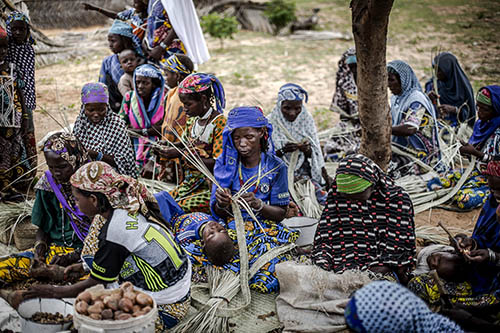


The broader focus of this report is facilitated by a significant increase in the availability of sex-disaggregated data. We have at our disposal many more different kinds of data than were available in 2011. A multitude of qualitative studies have emerged in recent years. More abundant sex-disaggregated global data are available across a variety of domains, including food insecurity, labour and access to finance and digital services. The establishment of the 17 Sustainable Development Goals and corresponding indicators has fostered increased availability of country-level data on key dimensions of women’s empowerment, such as access to land. National household and labour-force surveys have also enhanced the availability of sex-disaggregated data and gender statistics. This has been accompanied by a large increase in project and stand-alone household surveys with a primary focus on gender equality and women’s empowerment, with corresponding sex-disaggregated detail.
Using this enhanced sex-disaggregated data, the report has tried to move beyond comparison between female- and male-headed households, given the ample literature that underscores the limitations of such analysis. However, this has not been entirely possible because in many low- and middle-income countries farm activities in the household are carried out jointly by multiple household members and because of the still-limited availability of sex disaggregated data across time and space. Nationally representative sex-disaggregated data related to self-employment activities (in agriculture and off-farm), time use and access to assets are mostly available only in a relatively small number of countries in the Living Standards Measurement Study – Integrated Surveys on Agriculture (LSMS-ISA) and Living Standards Measurement Study – Plus (LSMS+) initiatives. For this reason, much of the cross-country comparative analysis of access to and use of productive resources, technology and extension is still limited to female versus male household head (and derivations thereof).
Despite a large increase in projects and interventions fostering gender equality and women’s empowerment in rural areas, along with related studies and analysis, available evidence documenting successful strategies to close gender gaps remains limited. Relatively few impact evaluations have been carried out and these often fail to capture change in the underlying discriminatory social norms and entrenched unequal power dynamics sustaining gender inequality. The strategies documented are of relatively small scale and offer incremental steps towards the achievement of gender equality and women’s empowerment.
Chapter 2 provides an overview of women’s work and productivity in agrifood systems. It provides a wealth of new data related to the participation of women and men in various parts of agrifood systems; where and how women participate in agrifood value chains; the quality of work in which women are engaged, including the gender wage gap in agrifood-systems employment; and the differences in land and labour productivity between men and women.
Chapter 3 investigates how women’s access to and control over assets, resources, services and local institutions has evolved in the last decade. It presents new data regarding women’s access to land and water resources, including security of access to these resources; reconsiders women’s access to the traditional complimentary resources and services necessary for agricultural production; and presents recent data on digital agriculture and rural women’s access to information and communications technologies.
Chapter 4 examines the role of agency in empowering women, drawing on new research that defines, measures and attributes women’s choices, bargaining power, preferences, capabilities and aspirations in agrifood systems. It reviews a growing body of evidence on the positive association of empowerment with improvements in diets, child nutrition, productivity and household-level food security. The chapter also investigates the informal social norms and roles that influence gender relationships, as well as the more formal laws, policies and institutions that shape women’s participation in agrifood systems.
Chapter 5 assesses how shocks and crises impact the opportunities and challenges for women and men in agrifood systems. It reviews the impact of the COVID-19 pandemic, climate change and conflicts, emphasizing the overlapping nature of crises and the pathways through which these crises have specific impacts on women and girls.
Chapter 6 draws out the main lessons learned from each of the previous chapters. In doing so, it highlights what has worked in improving women’s role in agrifood systems in practice and recommends actions for the future. The chapter presents key elements that are common across most successful interventions and provides insights on what works.
